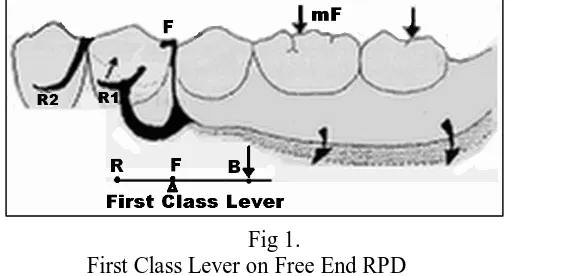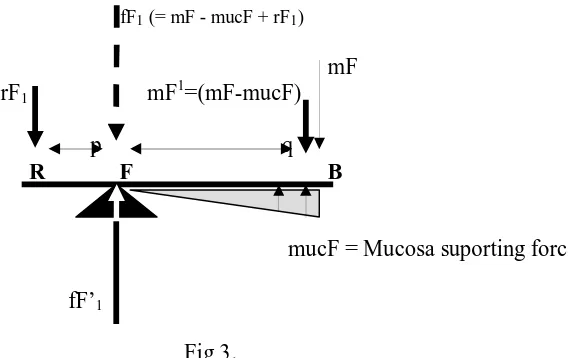Mastication Force Analysis on The Fulcrum point Of First Class Lever on Lower Jaw Distal Free End Denture
Rachman Ardan *
Key word: Mastication force; Free-end
Abstract
The problem in first class lever of free end (distal extension base) Removable Partial Denture (RPD) is the lever force on the retention point that may harm the abutment tooth have already discussed many times, but the amount of force on the Fulcrum point (rest) on the abutment tooth never been discuss yet. The objective of this paper is to analyze the amount of the force on the fulcrum point in first class lever of lower free end denture on the two dimension static model.
The analysis result reveal that the force on the Fulcrum point is bigger than the mastication force on the free end saddle, or the force on the fulcrum point is equal with the sum of the force on the saddle and the force on the retention point. The force on the fulcrum point may cause trauma to the periodontal tissue of the abutment tooth.
To decrease the amount of force on the fulcrum point is by : mastication force limitaton; decrease the distance between the mastication point and the fulcrum point; and increase the distance between retention point and fulcrum point. For clinical application many biological variables needs to be consider.
Introduction
Distal free end denture has more problems compared to all tooth supported denture. Kennedy tooth lost classification which is based on the topographic area pronged it as first class. 1-5. It indicates that distal free end denture requires special handling. The problem is unstable denture because there is no abutment tooth distal side of the free end saddle. Instability happened in vertical, horizontal, and distal direction.
Fig 1.
First Class Lever on Free End RPD
R = Retention point; F = Fulcrum point (Fulcrum); mF = Mastication Force
In vertical force direction, because no abutment tooth distal side of the free end saddle, denture support compressibility between abutment teeth (with occlosal rest) and alveolar mucosa, or between alveolar mucosa near abutment and alveolar mucosa on the distal part of the free end saddle is different. This condition especially in lower jaw, because on the area molar and retromolar, compressibility of the alveolar mucosa is very high. Research of Machmud compressibility of edentulous mucosa in lower jaw is more compressive towards posterior. Compressibility average in area first premolar = 0,34 mm; second premolar = 0,42 mm; First molar = 0,6 mm; second molar = 1,31 mm; third molar = 2,4 mm; and in retromolar pad area = 4,0 mm. 6
Unstable denture, at the time of mastication will cause leverage, and the center of rotation is on the nearest fulcrum point, and that is the nearest rest seat with its occlusal rest. Leverage could
happen in vertical direction, horizontal or combination. The main function of tooth is for mastication, hence the leverage of free end denture in vertical direction is more uppermost problem compared to another direction ( Figure 1). The design of retainer unit in free end denture could be first class lever or second class lever.
If the design of retainer unit is first class lever, the denture is more stable to mastication force compared to second class lever design, so that less alveolar ridge resorption on free end saddle. The disadvantage of this design is the abutment will be levered up, so that if it happen continuously will harm the abutment tooth. Upraised free end saddle by sticky food in design first class lever prevented by indirect retainer in anterior.
Design retainer second class lever is contrary to the first lever. The denture is less stable compare to first class lever and it cause more and more resorption of alveolar ridge, increase instablility and so on. Patient also feel less comfortable, besides irritation and generates ill taste at supported mucosa. Unstable denture also will lessen mastication efficiency and effectivity .
Calculation of force value should be considered, because although periodontal membrane is design to resist the mastication force, if it level is over, it will generate problems. The aim of this study is to analyse level of force at the fulcrum point on abutment tooth in case of Kennedy first class tooth lost classification.
Method and Analisis
To analized the value of force on fulcrum point, a design of two dimension static model in sagital direction that showing: denture; distal free end saddle; fulcrum point (the arm rest on abutment tooth), and retention point (representative of the ⅓ tip of retentive arm). Denture described as a horizontal straight bar. Bar at this model supported by most distal fulcrum point (occlusal rest). Mastication force works on free end saddle. Retention point is on the other tip of the bar. Position of fulcrum point is between mastication force (free end saddle) and retention point ( Figure 1 and 2).
When there is mastication force (= mF), the bar (denture) will rotated around the center of rotation on the fulcrum point until reach the static condition (non-movable). Retention point which is located in undercut area will lift the abutment tooth towards upward and backward. The amount of retentive force is = rF.
fF
rF mF
p q
R F M
fF’
Figure 2.
Design first class lever on Two Dimension Model RPD
F = Fulcrum (fulcrum point); R = Retention point; M = Mastication point; p = distance from F to R; q = distance from F to M; mF = Mastication Force; fF = force on fulcrum
Retentive force = rF, it mean that when abutment upraised by retentive arm, when reach static condition, as reaction there is force to the retentive arm (part of the denture) in equal value (= rF) ( fig. 2). Level or value of rF determined by the amount of mF and by comparison between distance R to F to distance F to M. Thereby mechanically the value of rF is countable as follows :
rF = q/p x mF
If has been reached static situation, resultante of mF and rF is fF . The value of fF is equal to the sum of rF and mF.
fF = mF + rF
Because value of rF has been known, hence countable fF value based on value mF :
Conclusion from above equation is that occlusal rest pressure (fF) to rest seat on abutment tooth always bigger than mastication force ( mF). Smallest pressure on fulcrum point (=0) will only equal to mastication force if p value = ~ ( infinite), and it is impossible. fF value will always bigger than mF value. More and more posterior tooths lost for free end denture ( long free end), more and more bigger fF value compared to mF value.
According to Gibs the value of mastication force is between 19,5 kgs. up to 26,7 kgs ( median value = 23,1 kgs.). This value is for natural tooths, while for artificial tooth would be smaller. 7 The study of Fadil, maximum functional mastication force of lower jaw canine is between 12,2 kgs. up to 20,9 kgs ( median value = 16,55 kgs). 8 Lower premolar would smaller than canine value, hence in RPD case with occlusal rest on premolar, the pressure is far above its functional maximum ability. It would hardly endangers for premolar tooth applied as a support.
Clinical reality, support for distal free end denture is not merely from occlusal rest only, but also obtained from attach mucosa. 9 As a result, when the lever reach static condition, the effect of mastication force on fulcrum point would be smaller. More wide free end base saddle, hence more small effect of mF on fulcrum point when reach static condition. Extension of free end base will minimized force per square, so that turn down of saddle will be lessened.
fF1 (= mF - mucF + rF1)
mF rF1 mF1=(mF-mucF)
p q R F B
mucF = Mucosa suporting force
fF’1
Fig 3.
Two dimension model of RPD, first class lever by cosidering mucosa support fF = mF + q/p mF
Solution
Base on above equation only, the way to overcome this problem is to lessen pressure in main fulcrum point are :
1. Minimizes q value
The distance from mastication point (M) to main fulcrum point (F) should be as near as possible. So the artificials teeth on the free end addle should as less as possible, for example until first Molar tooth.
2. Enlarges p value
It means that retention point (rF) should putting down retention point as anterior as possible. 3. Minimizes mF value
Value mF can be minimized for example by minimizing occlusal surface area of artificials teeth on the free end saddle, but it face mastication efficiency and effectivity. The mF value also can be minimized by giving instruction to patient to avoids heavy mastication load on the free end saddle.
Another way to overcome the problem besides with analysing equation is by increasing ability of supporting mucosa tissue in the area free end saddle, for example with: Implant 1,9,10; Stress Breaker 10; Flexible retentive clasp arm 9; Impression Technic 11,12; Additional retention and support from oposite side; Extends base until maximum (muscle trimming) for Free end saddle; and so on.
CONCLUSION
1. Distal free end RPD has more problems which requires special handling. 2. Main problem of distal free end RPD is unstabillity
3. Design first class lever retainer on distal free end RPD besides generate leverage to abutment tooth, also causes cumulative of pressure in main fulcrum point, and exceeding ability of abutment
4. To minimize pressure on main fulcrum point: a) Minimize mastication force: eats more soft food; b) Reduce the distance between place of bite to fulcrum point; c) Add distance between retention point to fulcrum point; d) maximize extension base
REFERENCES
1. Giffin KM. Solving Distal Extension Removable Partial Denture Base Movement Dilemma : A Clinical Report. J Prosthet Dent 1996; 76(4): 347-9.
2. Keng SB. Acrilic Resin Labial Flange for Kennedy Class I Partial Denture : A Clinical Report. J Prosthet Dent 1996; 75(2): 114-6.
3. Navas MTR, del Campo ML. A New Free End Removable Partial Denture Design. J Prosthet Dent 1993; 70(2): 176-8.
4. Boucher LJ, Renner RP. Treatment of Partially Edentulous Patients. St Louis, Toronto London: CV Mosby , 1982: ………
5. Henderson, D.; Steffel,V.L. 1973. McCracken’s Partial Prosthodontics. 4th ed. The CV.Mosby Co. St.Louis.
6. Machmud M, Ardan R, Lidan R. Studi Kasus Pola Distorsi Vertikal Jaringan Lunak Puncak Lingir Alveolar Berujung Bebas Rahang Bawah. Dept of Prosthet Dent, Dent Faculty, Padjadjaran. Univ, Bandung, Indonesia, 1996: ………….
7. Gibb CH, Mahan PE, Lundeen HC, Brechnan K, Walsh EK, Halbrook WB. Occlusal Forces During Chewing and Swallowing Measured by Sound Transmission. J Prosthet Dent 1981; 46(4): 443-9.
9. Margo A. Dukungan Gigi Tiruan Sebagian Lepasan. Dalam Buku Ajar Ilmu Gigi Tiruan Sebagian Lepasan Jilid I. Jakarta, Hipokrates, 1995: 134-50.
10.Mc Cracken WL. Contemporary partial denture design. J Prosthet Dent 2004; 92(5): 409-17 11.Leupold RJ. A Comparative Study of Impression Procedures for Distal Extension
Removable Partial Denture. J Prosthet Dent 1966; 16(4): 708-20.
12.Wang HY, Lu YC, Shiau YY, Tsou D. Vertical distortion in distal extension riges and palatal area of cast made by different techniques. J Prosthet Dent 1996 ; 75(3): 302-8


